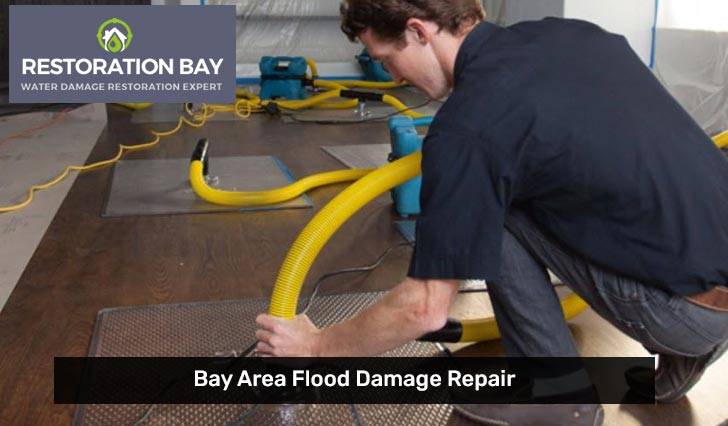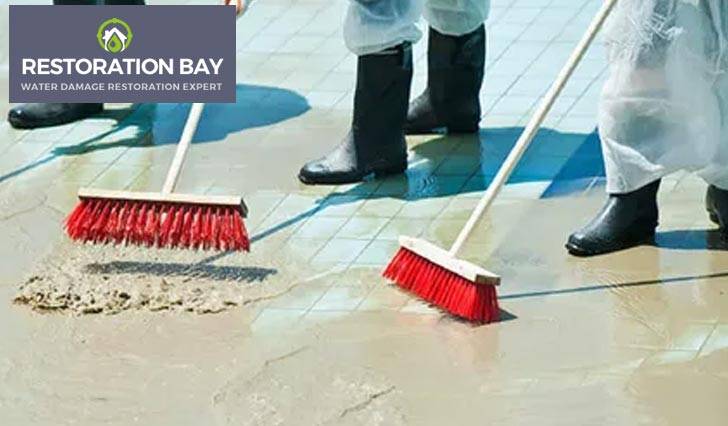- 24/7 Water Damage Emergency
- Direct Insurance Billing
Experiencing a flood in your home can be devastating, leaving damage that might seem overwhelming to address. As a resident of the Bay Area, you may face these challenges due to the region’s susceptibility to floods. But worry not, because effective solutions exist to restore your home to its former glory.
When your Bay Area home is flooded, it’s crucial to act swiftly. Start by assessing the flood damage, then call your insurance company. Next, pump out the water, clean and disinfect affected areas, and remove damaged items. Make temporary repairs and finally, engage a Bay Area Flood damage repair professional for comprehensive restoration.
In this article, we will outline the steps you need to take after your Bay Area home has been flooded, including how to assess the damage and contact your insurance company. We’ll also discuss the different types of flood damage and the necessary actions you should take to repair your home.

Floods can strike at any time and without warning, causing damage to your home and property. The aftermath of a flood can be overwhelming, but it’s important to take action as soon as possible to prevent further damage and begin the process of recovery. Here are some steps you should take after your home has been flooded.
The first step after a flood is to ensure the safety of yourself and your family. If you have evacuated, do not return to your home until authorities have deemed it safe to do so. Once you have entered your home, be cautious of potential hazards such as electrical wires or structural damage.
Before starting any clean-up or repairs, make sure to document the damage for insurance purposes. Take photos or videos of the affected area and any damaged belongings. This will help with your insurance claim and can also serve as a reference for repairs.
The longer water sits in your home, the more damage it can cause. Use a wet/dry vacuum or pump to remove standing water as soon as possible. If there is a large amount of water, you may need to hire professional services for water extraction. It’s important to thoroughly dry out your home to prevent mold growth and further damage. Open windows and doors for ventilation, use fans and dehumidifiers and remove any wet carpets or furniture.
Unfortunately, some items may be too damaged to salvage. Dispose of any items that cannot be properly cleaned and sanitized, including furniture, carpets, and drywall. It’s important to properly dispose of these items to prevent health hazards.
Flood waters can contain harmful bacteria and contaminants, so it’s important to thoroughly sanitize your home after a flood. Use a bleach solution (1 cup of bleach per gallon of water) on hard surfaces such as walls and floors. Any soft surfaces should be professionally cleaned or disposed of.
Flooding can cause structural damage to your home, so it’s important to check for any cracks, foundation issues, or other damage. If you notice any structural damage, contact a professional to assess and repair the issue.
Dealing with the aftermath of a flood can be emotionally and physically draining. To ensure a thorough restoration, Restoration Bay contractors specialize in Bay Area flood damage repair. We will assess the extent of the damage and provide a comprehensive plan for restoring your home.
Remember, dealing with a flooded home can be overwhelming, but taking prompt action and seeking professional assistance can help you recover and restore your home as quickly as possible.
Flood damages can be broadly categorized into three main types: structural, electrical, and health hazards.
Structural Damage is perhaps the most apparent type of damage. Floodwater can compromise the structural integrity of your home, causing problems like warped floors, deteriorated wall materials, and weakened foundations. Even a few inches of water can lead to significant damage, requiring extensive repairs.
Electrical Damage is another serious concern in flood-stricken homes. Floodwater can infiltrate electrical systems, causing short circuits, electrical fires, or electrocution risks. It’s crucial to have a professional evaluate and repair these systems before you return home.
Health Hazards stem from the potential contamination of floodwater. Backed-up sewage systems, chemical spillage, or other hazardous materials can mix with floodwater and infect your home. This contamination can lead to serious health problems if not promptly and adequately addressed.
The extent and nature of these damages can vary, making it essential to get a professional Bay Area flood damage repair service to assess the situation and undertake the necessary restorative measures. Contact us now!
After experiencing a devastating flood, assessing the extent of the damage to your beloved Bay Area home becomes an incredibly crucial step. To ensure a successful insurance claim, thoroughly document all damages.
This includes taking detailed photographs and creating a comprehensive list of affected items. When conducting your assessment, make sure to meticulously check all visible structures, keeping an eye out for any telltale signs of wear and tear, such as warped floors and walls.
However, it’s vital not to overlook the hidden areas, like crawl spaces and basements, as they can also bear the brunt of the flood’s impact. By conducting a thorough inspection of these often overlooked areas. You can ensure a precise and comprehensive assessment, enabling you to initiate the necessary repairs and restoration process with confidence and peace of mind.

After the damage assessment, your next crucial step is to contact your insurance provider. Reach out to them as soon as possible to report the flood damage to your home, making sure to provide them with all the necessary documentation you have gathered during the assessment phase. You must remain patient since insurance claims can sometimes take time to process.
When dealing with your insurance company, be sure to have your policy number on hand, and be prepared to detail the extent of property damage. Ask about what is covered under your policy to get a clear understanding of what financial support you can expect. Additionally, you should also inquire about the procedure for repairing your home, as some insurance companies may require you to work with specific Bay Area Flood Damage Repair contractors.
In the aftermath of a devastating flood, it is crucial to prioritize safety above all else. Taking swift action and seeking professional assistance becomes paramount to mitigate further damage and ensure a speedy recovery. With the comprehensive knowledge and step-by-step guidance outlined in this informative guide, you can navigate the challenging landscape of flood damage repair with confidence.
Remember, when dealing with such significant damage, professional Flood Damage Repair services are invaluable. Reach out now if your home has been impacted by a flood, and let us help you restore your house to a home again.